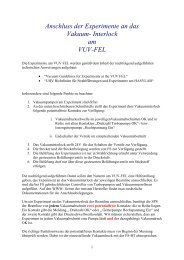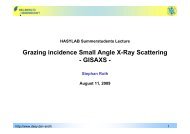The OTIS Reference Manual - Hasylab
The OTIS Reference Manual - Hasylab
The OTIS Reference Manual - Hasylab
Create successful ePaper yourself
Turn your PDF publications into a flip-book with our unique Google optimized e-Paper software.
DebugMode[5:3] Run time information WPWrap RPWrap<br />
3’b000 Zero crossing of Write pointer Read pointer<br />
memory write and read pointer<br />
3’b001 Zero crossing of Write pointer Read pointer<br />
derandomizing buffer pointer<br />
3’b010 Memory self test Self test busy Self test failure<br />
3’b011 Read out sequence Start of sequence End of sequence<br />
3’b100 Derandomizing buffer fill level Buffer empty Buffer full<br />
Table 4: Status information (<strong>OTIS</strong>1.0)<br />
�ReadMode: As <strong>OTIS</strong>1.0 only features the SingleHit operation mode, bits number 3 to 7 of<br />
the ReadMode register are ignored. Bit number 2 selects the operation mode (setting this bit<br />
to 0 is the only reasonable choice). ReadMode[1:0] represents the number of data sets that<br />
will be searched for hits upon incoming trigger signals. Note that the search depth figure<br />
starts counting from zero. Changes in the ReadMode register only take effect after a L0 reset<br />
signal.<br />
�DebugMode: Several internal status signals can be monitored at the two service pads WPWrap<br />
and RPWrap. <strong>The</strong> signals to observe can be selected with bits number 3 - 5 of the DebugMode<br />
register. Valid bit combinations are listed in table 4. DebugMode[2]=1 switches off signal<br />
monitoring, i.e. monitoring is enabled by default. <strong>The</strong> bits DebugMode[1:0] are used to<br />
select and activate one out of two special operation modes: DebugMode[1:0]=2’b11 selects<br />
memory self test mode, DebugMode[1:0]=2’b01 selects play back mode and 2’bX0 switches<br />
off the debug mode operation.<br />
�Latency: <strong>The</strong> content of the Latency register defines the latency, i.e. the distance between<br />
memory write and read pointer. Latency[7:0]=0x00 sets the minimum distance 1 where<br />
the read pointer immediately follows the write pointer. <strong>The</strong> maximum distance is 0xA2.<br />
Changes in the Latency register only take effect after a L0 reset.<br />
�ChannelMask: <strong>The</strong> 32 bits of the 4ChannelMask registers individually switch on or off single<br />
channels of the <strong>OTIS</strong> chip. To switch off a channel, the corresponding bit must be set to 1,<br />
i.e. all channels are switched on by default.<br />
�DLLDAC, ASDDAC: Interface to the unbuffered 8bit DLL and ASD voltage DACs.<br />
�PBData: Interface to the two shift registers that are used as storage for the play back data<br />
sets.<br />
5.2.2 Configuration Registers of <strong>OTIS</strong>1.1, <strong>OTIS</strong>1.2 and <strong>OTIS</strong>1.3<br />
<strong>The</strong> chips <strong>OTIS</strong>1.1, <strong>OTIS</strong>1.2 and <strong>OTIS</strong>1.3 provide a set of 66 status and configuration registers.<br />
Table 5 summarizes name, address, type and bit content of each register. <strong>The</strong> <strong>OTIS</strong> register<br />
set is composed of 5 read only and 61 writable registers. Though of type read-only, the registers<br />
StatusReg, ReceivedT and RejectedT allow to be re-initialized to zero by accepting and<br />
interpreting any write access as reset signal. <strong>The</strong> accompanying data byte is ignored.<br />
10










